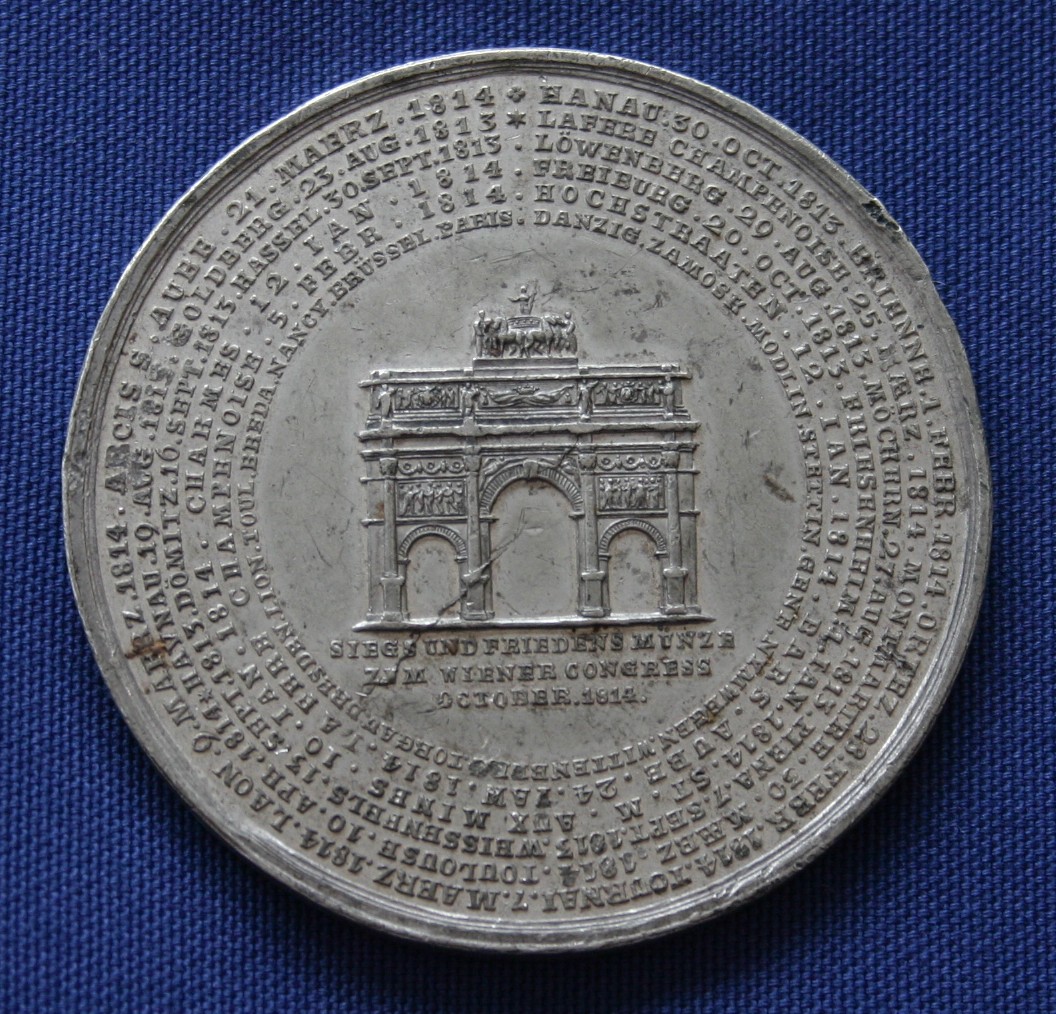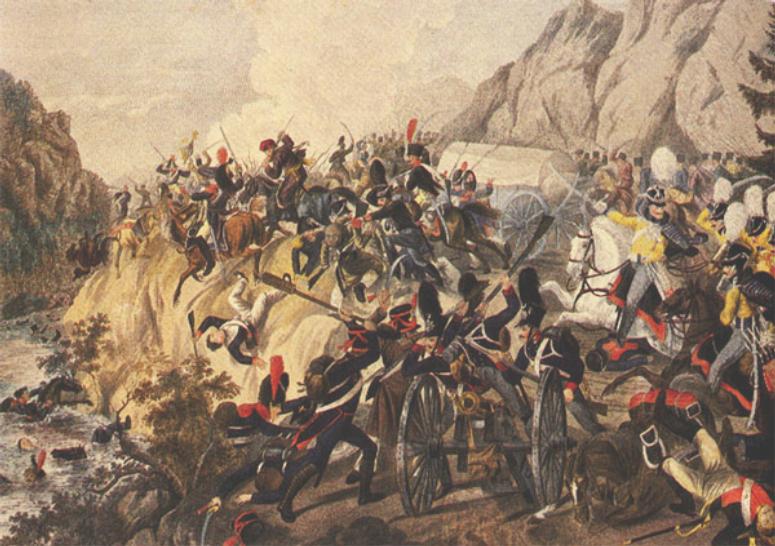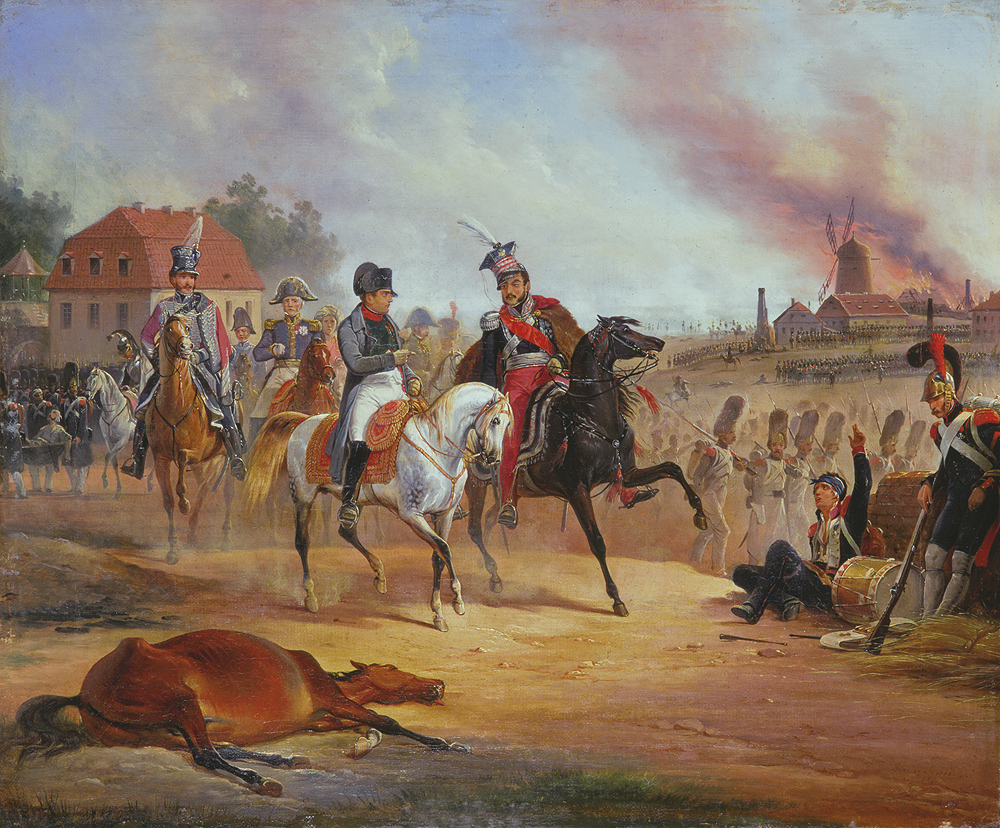|
Battle Of Dennewitz
The Battle of Dennewitz (german: Schlacht von Dennewitz (Battle near Jüterbog) took place on 6September 1813 between French forces commanded by Marshal Michel Ney and the Sixth Coalition's Allied Army of the North commanded by Crown Prince Charles John of Sweden, Friedrich Wilhelm von Bülow and Bogislav von Tauentzien. It occurred in Dennewitz, a village in the Prussian province of Brandenburg, near Jüterbog, southwest of Berlin. The battle marked a turning point in the German Campaign of 1813 as not only did the Allied victory end Napoleon's hopes of capturing Berlin and knocking Prussia out of the war, but the severity of the French defeat, inflicted by a primarily Prussian force, also led to the erosion of fidelity of German allies to the Napoleonic cause. The French losses, and consequent diplomatic reverses, that resulted from Dennewitz contributed greatly to Napoleon's defeat a month later at the Battle of Leipzig. Prelude In late August 1813, Napoleon decided to ... [...More Info...] [...Related Items...] OR: [Wikipedia] [Google] [Baidu] |
German Campaign Of 1813
The German campaign (german: Befreiungskriege , lit=Wars of Liberation ) was fought in 1813. Members of the Sixth Coalition, including the German states of Austria and Prussia, plus Russia and Sweden, fought a series of battles in Germany against the French Emperor Napoleon, his marshals, and the armies of the Confederation of the Rhine - an alliance of most of the other German states - which ended the domination of the First French Empire. After the devastating defeat of Napoleon's ''Grande Armée'' in the Russian campaign of 1812, Johann Yorck – the general in command of the ''Grande Armée'''s German auxiliaries (') – declared a ceasefire with the Russians on 30 December 1812 via the Convention of Tauroggen. This was the decisive factor in the outbreak of the German campaign the following year. The spring campaign between France and the Sixth Coalition ended inconclusively with a summer truce ( Truce of Pläswitz). Via the Trachenberg Plan, developed during a per ... [...More Info...] [...Related Items...] OR: [Wikipedia] [Google] [Baidu] |
Battle Of The Katzbach
The Battle of the Katzbach on 26 August 1813, was a major battle of the Napoleonic Wars between the forces of the First French Empire under Marshal MacDonald and a Russo-Prussian army of the Sixth Coalition under Prussian Marshal Graf (Count) von Blücher. It occurred during a heavy thunderstorm at the Katzbach river between Wahlstatt and Liegnitz in the Prussian province of Silesia. Taking place the same day as the Battle of Dresden, it resulted in a Coalition victory, with the French retreating to Saxony. Prelude Blücher ordered the Army of Silesia to advance on 13 August, before the Truce of Pläswitz could conclude on 17 August. In a series of running fights, the Allied army beat back the confused French, who did not anticipate that the Allies would break the armistice so brazenly. These minor victories raised the morale of the inexperienced German levies. On the first day, Blücher and his chief of staff August Neidhardt von Gneisenau became separated and did not iss ... [...More Info...] [...Related Items...] OR: [Wikipedia] [Google] [Baidu] |
Brandenburg
Brandenburg (; nds, Brannenborg; dsb, Bramborska ) is a state in the northeast of Germany bordering the states of Mecklenburg-Vorpommern, Lower Saxony, Saxony-Anhalt, and Saxony, as well as the country of Poland. With an area of 29,480 square kilometres (11,382 square miles) and a population of 2.5 million residents, it is the fifth-largest German state by area and the tenth-most populous. Potsdam is the state capital and largest city, and other major towns are Cottbus, Brandenburg an der Havel and Frankfurt (Oder). Brandenburg surrounds the national capital and city-state of Berlin, and together they form the Berlin/Brandenburg Metropolitan Region, the third-largest metropolitan area in Germany with a total population of about 6.2 million. There was an unsuccessful attempt to unify both states in 1996 and the states cooperate on many matters to this day. Brandenburg originated in the Northern March in the 900s AD, from areas conquered from the Wends. It later became the ... [...More Info...] [...Related Items...] OR: [Wikipedia] [Google] [Baidu] |
Prussia
Prussia, , Old Prussian: ''Prūsa'' or ''Prūsija'' was a German state on the southeast coast of the Baltic Sea. It formed the German Empire under Prussian rule when it united the German states in 1871. It was ''de facto'' dissolved by an emergency decree transferring powers of the Prussian government to German Chancellor Franz von Papen in 1932 and ''de jure'' by an Allied decree in 1947. For centuries, the House of Hohenzollern ruled Prussia, expanding its size with the Prussian Army. Prussia, with its capital at Königsberg and then, when it became the Kingdom of Prussia in 1701, Berlin, decisively shaped the history of Germany. In 1871, Prussian Minister-President Otto von Bismarck united most German principalities into the German Empire under his leadership, although this was considered to be a " Lesser Germany" because Austria and Switzerland were not included. In November 1918, the monarchies were abolished and the nobility lost its political power durin ... [...More Info...] [...Related Items...] OR: [Wikipedia] [Google] [Baidu] |
Dennewitz
Dennewitz is a village of Germany, in the federal state and old Prussian province of Brandenburg, near Jüterbog, 40 km. S.W. from Berlin. It is part of the municipality of Niedergörsdorf, Teltow-Fläming district. History It is memorable as the scene of a decisive battle on the 6 September 1813, during the Napoleonic Wars, specifically the War of the Sixth Coalition, in which Marshal Ney, with an army of 58,000 French, Saxons and Poles, was defeated with great loss by an allied army with 85,000Barton, Sir Dunbar Plunket (1925). Bernadotte: Prince and King. Pp. 91-92. John Murray. Prussians, Swedes and Russians led by Prussian generals von Bülow (afterwards Count Bülow of Dennewitz) and Tauentzien and the commander of the Allied Army of the North, Swedish Crown Prince and Regent Carl Johan. The Swedish corps was commanded by Field Marshal Kurt von Stedingk. The site of the battle is marked by an iron obelisk. During the battle, and in the subsequent pursuit, Napoleon's ... [...More Info...] [...Related Items...] OR: [Wikipedia] [Google] [Baidu] |
Siege Of Hamburg
The city of Hamburg was one of the most powerful fortresses east of the Rhine. After being freed from Napoleonic rule by advancing Cossacks and other following Coalition troops it was once more occupied by Marshal Davout Louis-Nicolas d'Avout (10 May 1770 – 1 June 1823), better known as Davout, 1st Duke of Auerstaedt, 1st Prince of Eckmühl, was a French military commander and Marshal of the Empire who served during both the French Revolutionary Wars and th ...'s French XIII Corps on 28 May 1813, at the height of the German Campaign during the War of the Sixth Coalition from French rule and occupation. Ordered to hold the city at all costs, Davout launched a characteristically energetic campaign against a similar numbered Army of the North made up of Kingdom of Prussia, Prussian and other Coalition troops under the command of Ludwig von Wallmoden-Gimborn, Count von Wallmoden-Gimborn, winning a number of minor engagements. Neither force was decidedly superior and the ... [...More Info...] [...Related Items...] OR: [Wikipedia] [Google] [Baidu] |
Battle Of Sehested
The Battle of Sehested was fought between Danish and Russian-Prussian-British troops at Sehested (in Holstein) on 10 December 1813 during the War of the Sixth Coalition. The Danish Auxiliary Corps, which fought on the side of the French defeated the coalition forces commanded by Major General Ludwig von Wallmoden-Gimborn. The battle, however, would not ultimately change the course of the war, which ended in 1814 with Denmark’s defeat. Background The kingdom of Denmark-Norway found itself involved in the Napoleonic Wars following the events of the Battle of Copenhagen in 1807. To prevent the large Danish-Norwegian fleet from falling into the hands of Napoleon's French Empire, the United Kingdom attacked Copenhagen destroying ships at anchor. The Danish-Norwegians though had no intention of joining Napoleon. Moreover the decision to seize the Danish-Norwegian navy, before they fell into french hands, was done on the basis of a fallacious report send by a british army ... [...More Info...] [...Related Items...] OR: [Wikipedia] [Google] [Baidu] |
Battle Of Hanau
The Battle of Hanau was fought from 30 to 31 October 1813 between Karl Philipp von Wrede's Austro-Bavarian corps and Napoleon's retreating French during the War of the Sixth Coalition. Following Napoleon's defeat at the Battle of Leipzig earlier in October, Napoleon began to retreat from Germany into France and relative safety. Wrede attempted to block Napoleon’s line of retreat at Hanau on 30 October. Napoleon arrived at Hanau with reinforcements and defeated Wrede’s forces. On 31 October Hanau was in French control, opening Napoleon’s line of retreat. The Battle of Hanau was a minor battle, but an important tactical victory allowing Napoleon’s army to retreat onto French soil to recover and prepare to face an invasion of France. Background The Battle of Leipzig, the largest and bloodiest encounter of the Napoleonic Wars, began on 16 October 1813, raged for three days and ended with a decisive victory for the Sixth Coalition. Napoleon was forced to abandon central ... [...More Info...] [...Related Items...] OR: [Wikipedia] [Google] [Baidu] |
Battle Of Leipzig
The Battle of Leipzig (french: Bataille de Leipsick; german: Völkerschlacht bei Leipzig, ); sv, Slaget vid Leipzig), also known as the Battle of the Nations (french: Bataille des Nations; russian: Битва народов, translit=Bitva narodov), was fought from 16 to 19 October 1813 at Leipzig, Saxony. The Coalition armies of Austria, Prussia, Sweden, and Russia, led by Tsar Alexander I and Karl von Schwarzenberg, decisively defeated the ''Grande Armée'' of French Emperor Napoleon Bonaparte. Napoleon's army also contained Polish and Italian troops, as well as Germans from the Confederation of the Rhine (mainly Saxony and Württemberg). The battle was the culmination of the German Campaign of 1813 and involved 560,000 soldiers, 2,200 artillery pieces, the expenditure of 400,000 rounds of artillery ammunition, and 133,000 casualties, making it the largest battle in Europe prior to World War I. Decisively defeated again, Napoleon was compelled to return to France w ... [...More Info...] [...Related Items...] OR: [Wikipedia] [Google] [Baidu] |
Battle Of Wartenburg
The Battle of Wartenburg (german: Schlacht bei Wartenburg) took place on 3October 1813 between the French IV Corps commanded by General Henri Gatien Bertrand and the Allied Army of Silesia, principally the I Corps of General Ludwig von Yorck. The battle allowed the Army of Silesia to cross the Elbe, ultimately leading to the Battle of Leipzig. Prelude Following the his defeat at the battle of Dennewitz, Marshal Ney withdrew his army to defensive positions along the Elbe. The allied Army of the North, under the command of Crown Prince Charles John of Sweden (formerly French Marshal Bernadotte), followed them cautiously but made no serious effort to cross the river. To the east, Marshal Blücher made a bold march skirting Napoleon's position in Dresden to join his Army of Silesia with the Army of the North, cross the Elbe, and threaten Napoleon's communications with France. Major von Rühle was tasked with finding a crossing point where the bridgehead could, if necessary, ... [...More Info...] [...Related Items...] OR: [Wikipedia] [Google] [Baidu] |
Combat Of Roßlau
The Combat of Rosslau was fought in the War of the Sixth Coalition on 29 September 1813, near Rosslau, Germany. Michel Ney attacked the Swedish bridgehead at the Elbe, to stop the Army of the North from crossing the river. The Swedish commander Johan August Sandels counterattacked and chased the French for before being forced to retire himself. About 350 Swedes were dead and wounded while the French had at least 1,500, according to Swedish sources. The battle had no strategic effects, but it was one of very few times in the war that a Swedish force was fully committed in battle. Background A French force under Michel Ney had received orders from Napoleon I to attack the Swedish bridgehead over the Elbe river, at Rosslau, to stop the Army of the North (under the Swedish Crown Prince Charles John) from reaching Leipzig. After having fought a couple of skirmishes for control over Dessau, Ney marched his troops of about 7,000–8,000 men towards the Swedish left flank. The Swe ... [...More Info...] [...Related Items...] OR: [Wikipedia] [Google] [Baidu] |
Battle Of Altenburg
The raid at Altenburg on 28 September 1813 took place during the War of the Sixth Coalition's German Campaign of 1813. The raid was carried out by the ''Streifkorp'' under the command of Saxon General Johann von Thielmann commanding seven regiments of Cossacks, a squadron each of Saxon Hussars and Dragoons, and a detachment of ''Saxon Freikorps'' numbering about 1,500 cavalry. The objective of the raid was to attempt harassment of the French lines of communication 25 miles (45 km) south of Leipzig shortly before the Battle of Leipzig. The Austrian contingent was commanded by Emmanuel Mensdorff and the Russian contingent of Cossacks by Matvei Platov. Background The battle was the culmination of a raid in which Thielmann cavalry successfully attacked Napoleon's lines of communications along the roads between Erfurt and Leipzig in the Saale valley. Battle Thielmann completely surprised and routed a larger force of French cavalry, including Cavalry of the Imperial Guar ... [...More Info...] [...Related Items...] OR: [Wikipedia] [Google] [Baidu] |




